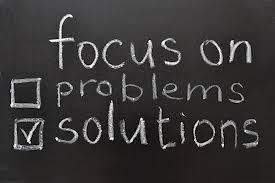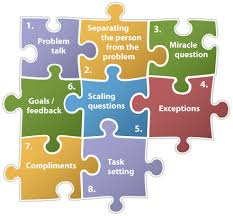 These were developed in America in the 1980s by Steve de Shazer and Insoo Kim Berg. After spending many years studying problem behaviour and trying to change it they changed their focus to studying ‘solution behaviour’ and how to promote it. Two simple ideas underlie these approaches.
These were developed in America in the 1980s by Steve de Shazer and Insoo Kim Berg. After spending many years studying problem behaviour and trying to change it they changed their focus to studying ‘solution behaviour’ and how to promote it. Two simple ideas underlie these approaches.
- Nobody is perfect and this applies to our problems as well as everything else. If no one can ‘do’ their problem perfectly there must always be ‘exception’ times when the problem behaviour is not seen. Whatever the person is doing differently at these ‘exceptional’ times will be the basis of a potential solution. The aim is therefore to discover whatever a person is already doing which might contribute to the resolution of the problem with which they have come.
- Knowing where you want to get to makes the getting there much more likely. One of the common consequences of a serious problem is that it clouds our view of the future. We know that we don’t want the problem but we have lost sight of what it is we do want. Solution focused approaches ask lots of questions about what life might be like if the problem was solved. This enables a picture of a preferred future to be created and the clearer this becomes the greater the possibility of it beginning to happen.
Adapted from what is the solution focused approach
Assumptions underlying solution focused working
- Whatever the problem there will always be exceptions (times when the problem is less or absent).
- All individuals have hopes for the future where the problem is not present.
- Everyone has the resource to solve their problems – they just don’t know it.
The essence of solution focused working aims to:
- Work with the person rather than the problem.
- Look for resources, strengths, abilities, useful qualities/beliefs and skills rather than deficits.
- Explore possible and preferred futures.
- Explore what is already contributing to those possible futures.
- Treat all individuals as the experts in all aspects of their lives.
- Avoid trying to understand what causes and maintains a problem and how to fix it.
Educational Psychologists are trained to use solution-focused approaches within consultations, with groups and individuals. Solution focused intervention offers a framework for thinking within all of the work which the service engages in.
Some examples of solution focused questions:
- So what did it take to do that?
- What helped you achieve it?
- How did you do that?

- How did you deal with that?
- What did you learn about yourself by managing to do that?
- What might others have learned about you from that?
- How will you know that things are improving?
- How will you know that the problem is solved?
- What will you be doing differently?
- Who will notice first?
- What will others be doing differently
- Let’s imagine that tomorrow turns out to be a good day for you, how will you know that it is going well?
Some examples of techniques
The Miracle question script: Imagine that tonight while you are asleep a miracle happens and your hopes all come true (or your problems are solved). Because you are asleep you don’t realise that a miracle has happened. When you wake up, what is the first thing you’re going to notice that is different and that tells you the miracle has happened?
Scaling: helping individuals or groups to consider where they are on scale from 0-10 in relation to problems can be effective in charting the next small step or end aim. Example scales – where are you on the scale?
Work is terrible 0 1 2 3 4 5 6 7 8 9 10 Work is great
The problem at its worst 0 1 2 3 4 5 6 7 8 9 10 The problem is gone
No one likes me 0 1 2 3 4 5 6 7 8 9 10 I am popular
No confidence 0 1 2 3 4 5 6 7 8 9 10 Absolutely confident
Not prepared to change 0 1 2 3 4 5 6 7 8 9 10 Prepared to do anything
Some example scaling questions might be:
Where do you see things right now? What is it that helped you get from ‘0’ to here?
What is stopping things going down to a ‘3’? Have you been at a ‘2’ before?
How did you move up? What would have to happen to move up to (next point)?
What tells you that you are there and not lower?

